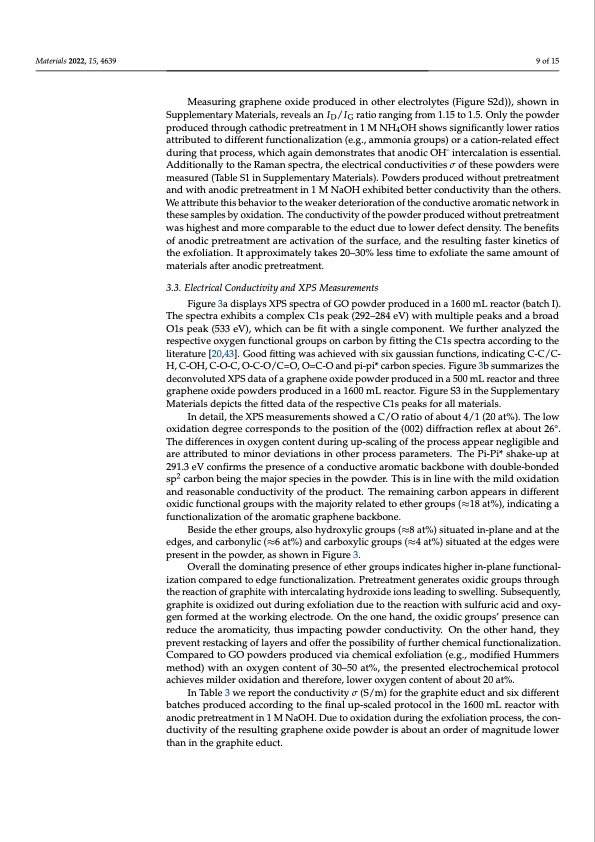
PDF Publication Title:
Text from PDF Page: 009
Materials 2022, 15, 4639 9 of 15 Measuring graphene oxide produced in other electrolytes (Figure S2d)), shown in Supplementary Materials, reveals an ID/IG ratio ranging from 1.15 to 1.5. Only the powder produced through cathodic pretreatment in 1 M NH4OH shows significantly lower ratios attributed to different functionalization (e.g., ammonia groups) or a cation-related effect during that process, which again demonstrates that anodic OH- intercalation is essential. Additionally to the Raman spectra, the electrical conductivities σ of these powders were measured (Table S1 in Supplementary Materials). Powders produced without pretreatment and with anodic pretreatment in 1 M NaOH exhibited better conductivity than the others. We attribute this behavior to the weaker deterioration of the conductive aromatic network in these samples by oxidation. The conductivity of the powder produced without pretreatment was highest and more comparable to the educt due to lower defect density. The benefits of anodic pretreatment are activation of the surface, and the resulting faster kinetics of the exfoliation. It approximately takes 20–30% less time to exfoliate the same amount of materials after anodic pretreatment. 3.3. Electrical Conductivity and XPS Measurements Figure 3a displays XPS spectra of GO powder produced in a 1600 mL reactor (batch I). The spectra exhibits a complex C1s peak (292–284 eV) with multiple peaks and a broad O1s peak (533 eV), which can be fit with a single component. We further analyzed the respective oxygen functional groups on carbon by fitting the C1s spectra according to the literature [20,43]. Good fitting was achieved with six gaussian functions, indicating C-C/C- H, C-OH, C-O-C, O-C-O/C=O, O=C-O and pi-pi* carbon species. Figure 3b summarizes the deconvoluted XPS data of a graphene oxide powder produced in a 500 mL reactor and three graphene oxide powders produced in a 1600 mL reactor. Figure S3 in the Supplementary Materials depicts the fitted data of the respective C1s peaks for all materials. In detail, the XPS measurements showed a C/O ratio of about 4/1 (20 at%). The low oxidation degree corresponds to the position of the (002) diffraction reflex at about 26°. The differences in oxygen content during up-scaling of the process appear negligible and are attributed to minor deviations in other process parameters. The Pi-Pi* shake-up at 291.3 eV confirms the presence of a conductive aromatic backbone with double-bonded sp2 carbon being the major species in the powder. This is in line with the mild oxidation and reasonable conductivity of the product. The remaining carbon appears in different oxidic functional groups with the majority related to ether groups (≈18 at%), indicating a functionalization of the aromatic graphene backbone. Beside the ether groups, also hydroxylic groups (≈8 at%) situated in-plane and at the edges, and carbonylic (≈6 at%) and carboxylic groups (≈4 at%) situated at the edges were present in the powder, as shown in Figure 3. Overall the dominating presence of ether groups indicates higher in-plane functional- ization compared to edge functionalization. Pretreatment generates oxidic groups through the reaction of graphite with intercalating hydroxide ions leading to swelling. Subsequently, graphite is oxidized out during exfoliation due to the reaction with sulfuric acid and oxy- gen formed at the working electrode. On the one hand, the oxidic groups’ presence can reduce the aromaticity, thus impacting powder conductivity. On the other hand, they prevent restacking of layers and offer the possibility of further chemical functionalization. Compared to GO powders produced via chemical exfoliation (e.g., modified Hummers method) with an oxygen content of 30–50 at%, the presented electrochemical protocol achieves milder oxidation and therefore, lower oxygen content of about 20 at%. In Table 3 we report the conductivity σ (S/m) for the graphite educt and six different batches produced according to the final up-scaled protocol in the 1600 mL reactor with anodic pretreatment in 1 M NaOH. Due to oxidation during the exfoliation process, the con- ductivity of the resulting graphene oxide powder is about an order of magnitude lower than in the graphite educt.PDF Image | Electrochemical Production Thermal Reduction Graphene Oxide

PDF Search Title:
Electrochemical Production Thermal Reduction Graphene OxideOriginal File Name Searched:
materials-15-04639.pdfDIY PDF Search: Google It | Yahoo | Bing
Salgenx Redox Flow Battery Technology: Power up your energy storage game with Salgenx Salt Water Battery. With its advanced technology, the flow battery provides reliable, scalable, and sustainable energy storage for utility-scale projects. Upgrade to a Salgenx flow battery today and take control of your energy future.
| CONTACT TEL: 608-238-6001 Email: greg@infinityturbine.com | RSS | AMP |